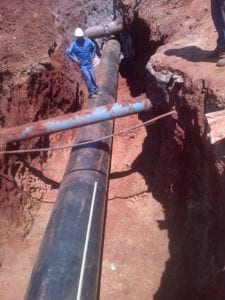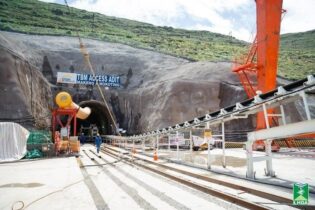By Nicholas McDiarmid editor, IMIESA
In a substantial pipeline upgrade project, Ekurhuleni Metropolitan Municipality recently completed the replacement of more than 1.4 km of asbestos cement (AC) pipeline, which dated from the 1980s, with 560mm diameter, locally manufactured high-density polyethylene (HDPE) pipe. Mapitsi Civil Works was selected as the contractor for the project, due to its extensive experience in the laying pipelines for civil and municipal projects, while fluid conveyance equipment supplier Incledon oversaw the supply of the R4.3 million worth of pipes and valves that went into the project. Robinson Patji, sales representative for Incledon, notes that the company was contracted to supply HDPE pipe due to its high-impact strength, low friction and flexible properties. “AC pipelines pose some potential health concerns for both workers and end-users. These pipes are also very brittle and tend to crack under stress from trench loads. The brittleness also makes this type of pipe difficult to cut and splice to undertake repair work,” he explains. Patji adds that HDPE is non-toxic and entirely safe for supplying drinking water, while the lightness of the material makes it an easier and quicker type of pipeline to install. “The lightweight properties of HDPE make it easier for workers to carry and lay. More pipes can be loaded onto a truck, thereby reducing carbon emissions. HDPE pipes also boast more impact strength than AC pipes, which substantially reduces the risk of cracking and subsequent leaks.” According to Patji, the SANS 4427 approved pipes, which have a pressure rating of 12.5 bar, were delivered to the project in 12 m lengths by Incledon. As part of its comprehensive service offering, Incledon also sourced a professional welding contractor on behalf of the municipality, in addition to supplying the project with a range of AVK valves in sizes including 200 mm, 300 mm and 500 mm. The construction process Mapitsi Civil Works is approximately eight years old and has established a trusted relationship with Ekurhuleni Municipality and has been associated with Incledon for the last four years. Andre Venter of Mapitsi Civil Works was the engineer on the project and notes that Vosloorus, in Guateng’s East Rand, is a dolomitic area, which is fairly unstable, requiring a more flexible pipe. “After initial consultation with Ekurhuleni Municipality, it was decided not use steel but to use HDPV plastic pipes due to the dominance of dolomite in the ground. Dolomite makes for an unstable environment that moves quite a lot and is not good for steel pipes. HDPE pipe has the flexibility required.” Excavation and blasting Venter notes that a brand new trench was dug in this project. “We chose a new route and used standard excavators to create the trench, but because of the high concentration of dolomite in the area, we used a lot blasting in the making of the new trench. This was quite a process. We first excavated to find rock at an invert of around 400 m. An average trench is around 1.6 m, but there were areas that were much deeper due to road crossings. Once the rock was found, it was cleaned and then the blasters were brought in with compressors and drills to expose as much rock as possible. The rock was then charged with dynamite and covered in sand.” Venter explains that the sand was required as a safety measure in a residential area. “There is a Safety Act and an Act that covers blasting. Mats are used when there is not enough soil available.” Blasting was performed every 100 m. In any blasting situation, the geologic structure of the rock mass will be the most important consideration. Other considerations include the degree of scarring that would be acceptable (some areas can tolerate more blasting scars than others), cost and safety (blasting cannot be performed in close proximity to populated areas).Trench
When excavating and digging a trench for large pipelines, the amount of working space around the pipe in the trench is subject to SABS Standard: 1200. “You don’t want rock too close to the pipe, especially in dolomitic areas,” says Venter. “You blast around 400 m deeper than pipe’s eventual depth and then add common filler material for 200 m, followed by 200 m of a much finer material called blanket fill, which is comprised of a variety of materials. This is to accommodate the movement of the pipe due temperature-related contraction and expansion as well as the surrounding movement you have in dolomitic areas. Although HDPE pipes are not subject to the same corrosion problems found in steel pipes, they are still sensitive to the pH of the surrounding materials. A lot of soil testing is done ahead of time, and in acidic environments, more neutral soil must be shipped to the site.” The compaction of the soil is achieved using a procedure called Mod AASHTO and is applied to both the blanket and the common fill. Mod AASHTO compaction accounts for density, moisture content and the ratio of dry and wet density. Handling, laying and welding HDPE Venter, who has had a long and successful career working with steel pipes, is enthusiastic about working with HDPE: “This has been a completely new experience for me; while the properties of plastic pipe are impressive, the process of laying it takes a little longer. It is significantly lighter than steel and far more flexible. Handling it is a lot less stressful as it copes with occasional drops and accidents and is not sensitive to surface damages.” The technique of butt-welding is the welding of two pipes together by applying heat to the two ends of pipe and then forcing them together – a process that is a lot more complex than it sounds. Patji explains that because of the crucial nature of butt-welding, each weld itself undergoes certification by the municipality. “Before the welding itself was done, Ekurhuleni Municipality required the welder to demonstrate his competence prior to granting him a licence to proceed. This is required for each weld. A demo weld was performed on-site by the prospective welder in the presence of the municipal engineer. He was then certified to perform each weld. The reason for this amount of attention is due to the high risk of leakage. These pipes work at a pressure of 12.5 bar; this means any weakness in the weld will result in leaks. The depth of the pipe makes any future repair work especially challenging.” Butt-welding entails the placement of a hot plate between the pipes to be welded, which then heats the two sides to about 180°C. The two surfaces are then brought together under controlled pressure for a specific cooling time – in this case, one hour – and homogeneous fusion is formed upon cooling. When the two pipes are pushed together, a lip is created where the pipes are joined, acting as its own solder. The resultant joint is resistant to end thrust and has comparable performance under pressure to the pipe itself. In this project, pipes were welded together every 12 m. Testing There is a lot of testing that occurs during the laying of a pipeline of this nature. The welder is tested every three years or so. Once the welding is done, the weld itself is tested and certified. This was done by cutting samples and sending them for non-destructive testing. The consulting engineers also attended placing and welding who performed quality control. The whole pipe itself is pressure tested to one-and-a-half times the normal pressure for three hours. “In dolomitic areas, it is especially difficult to detect leaks, as water seeks out the easiest paths and collects in cavities and can’t be seen from the surface. This is the reason for the pervasion of sink-holes in dolomitic areas,” says Venter, explaining the importance of scrupulous welding and testing. Commissioning “We arranged a shutdown of the five different network connections and then worked to attach the new pipeline to the AC steel pipes, and have thus eliminated a significant amount of asbestos pipeline from the network,” says Venter. The contract was officially completed in mid-2013 without any major challenges encountered, states Patji. “Incledon has developed an excellent relationship with the local municipal council and assisted with storing the exact product specifications on our database to ensure prompt service delivery. Despite some minor interruptions that were swiftly overcome, the project was successfully completed on time and within budget.” As municipalities across South Africa continue to invest more capital into pipeline upgrades, Patji is confident of the future outlook for Incledon in the civils market. “Incledon has successfully supplied large volumes of piping products to numerous municipalities nationwide, with a number of tenders currently pending. I believe that the potential for future growth in the municipal market is strong, as a result of Incledon’s excellent reputation for providing top-quality products that are backed-up by our commitment to high levels of after-sales support,” he concludes.







